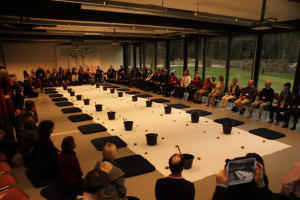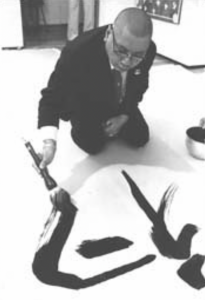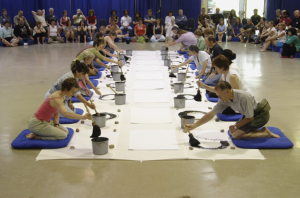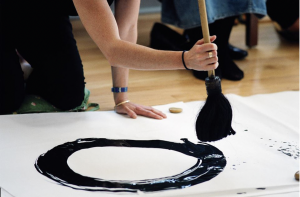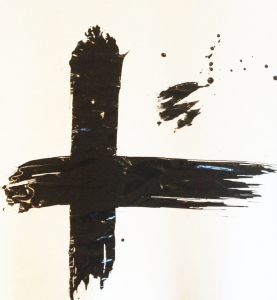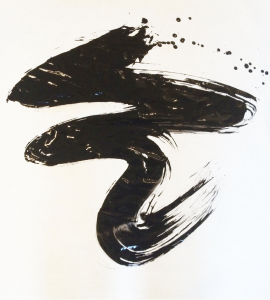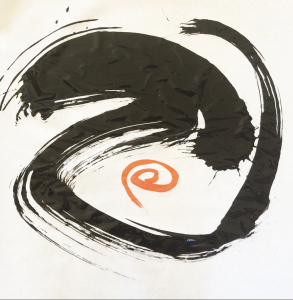Monday
Arts and PoetryEmbodied Mark Making: The Big Brush Experience
Barbara Bash
Two hundred people sit on chairs lining the sides of a large room. In the center of the space lengths of white paper stretch down the floor, buckets of ink with large bamboo handled brushes are placed near the cushioned seats, a round rock rests on each corner of the large sheets of paper. Everything is ready.
This is the set up for the Big Brush group practice I have been guiding over the years. Corporate bankers and consultants, coaches and recovering mental health patients, Buddhist practitioners , students and even children have all participated. It is a process that creates a space to join individual embodied mark making with community art expression.
On July 12 -14, 2019 I will be teaching BIG BRUSH MIND at Sky Lake Meditation Center in Rosendale, New York. This brush practice ritual will be a central grounding element of the workshop.
The seeds of this practice began with meeting Chogyam Trungpa, a Tibetan buddhist meditation teacher, in the early 1970’s. I had been working for a number of years as a western calligrapher, bringing my love of the alphabet and the scripts of the Middle Ages into contemporary graphic design, bookmaking and calligraphic commissions. I was involved in the precision, delicacy and intense focus of the calligraphic form, but something inside was longing to take more risk and be bold. In 1978 I attended a talk by Trungpa at Naropa University in Colorado on Dharma Art. He described Dharma Art as an expression of non-aggression and well being rather than neurosis. He said the work of a dharmic artist came from a place of sanity, a settled state of mind, and that living an artistic life was a fundamentally human act, available to all,. Then he said, “It’s possible to make a brush stroke that expresses your whole life.”
I sat in the middle of the crowd taking in these words, letting them land inside and expand my mind -“This means a really BIG brushstroke.” Looking back on this moment I recognize my inner teacher guiding me towards working larger, looser, involving the whole body as a counterbalance and enrichment to my precision. Over the next ten years the Big Brush practice became my vehicle for taking more risk and getting grounded in my body. It also brought with it the companionship and delight of community art making.
Getting ready for a Big Brush session, my preparation is focused and intense. It feels like setting the table for a huge feast, every object placed exactly. Beginning with a clean, clear, uplifted environment opens and invites in the nourishment and unpredictable nature of the creative act.
Here is how it works –
Participants come up (four at a time or more depending on the size of the group) and kneel on the cushions. I introduce the principles of heaven, earth and human as the form that we will be following in the making of our abstract strokes. Trungpa had presented these ancient Asian principles in a fresh and universal way. This will be the essential structure that will hold us through the process and give our strokes strength and integrity.
To begin I ask everyone seated to bow together. A simple bow brings one into the present and bowing together is a collective act. Then each person enters the solo space of making a stroke. When everyone is finished all bow together again as a marking of completion and a return to the larger group awareness. The strokes are folded up, set aside, and a new sheet laid down for the next person. A new group comes up and the sequence continues.
The folding up of the strokes developed out of a logistical need to contain and manage so much
wet ink, but this letting go has become a powerful teaching in itself, offering the experience of not holding on to the results of our actions. There are always more brushstrokes ready to be born. It is possible to trust this endless creative energy available to us all.
For the first stroke everyone is asked to make a circle on the page – an ancient symbol of wholeness and unity. I suggest the focus for this first stroke be on
the inner/feeling experience. The principle of heaven is the uncertainty one feels when facing the unknown, in this case the blank page. Trungpa called it a “positive panic”, a gathering of one’s energy, a natural trembling. The earth principle is felt as the movement into action – picking up the brush, becoming engaged, grounded, connected to the page. The human quality is about noticing how we feel about what we have done – curious, inquisitive, open, without judgment.
After everyone has made the first circle, the instruction for the second round is to make three strokes on one sheet – a vertical stroke for heaven, a horizontal stroke for earth, a dot for human. The focus expands now to include spontaneous design, an awareness of the relationship between the strokes, their different qualities, and developing the ability to know where each mark is needed to balance, complete and resolve.
In the third round everyone makes one continuous stroke that moves through all three stages – heaven is landing on the page, beginning to move, setting the tone, then shifting to earth -responding, counterbalancing, and human as a way to end, complete, lift off the page.
For the fourth round the instruction is to make one stroke that expresses the beginning of heaven and the counterbalancing of earth. Then the human stroke is made with a small brush dipped in bright red ink – warm, direct and accurate. Now the deepest aspects of the heaven, earth, hum
an principles are offered: heaven as the basic goodness of the whole situation, a natural sacredness; earth as freedom from laziness and a deep relaxation within action and human as letting go of subconscious gossip, our internal commentary, and having no regrets.
Being held by the ancient and natural order of heaven, earth and human a fresh beauty shows up again and again in the abstract marks people make. When we allow our actions to be guided by this universal form, what comes forth is good, worthwhile and embodied.
In the deepest sense, the art of calligraphy is the beautiful writing of this moment. The directness and immediacy of a brushstroke joins the space and vision of mind with the embodiment of form, body and tools. Creating a brushstroke is the act of bringing heaven down to earth.
Showing up fully connects us to our life. A brushstroke brings us onto this path of aliveness. The deeper the involvement in what we do, the more tenderness and compassion we have for the world. In the Big Brush practice we let ourselves be seen, and we see others truly.
The visual expression of aliveness wakes up and enlivens the viewer. This is the importance of art in the world. It is a passing of energy from person to person. The Big Brush practice brings everyone along on this path of art and awakening. It is possible for us all to express our life in a brushstroke and in that moment be whole.
BIG BRUSH MIND: A 3 day art retreat with Barbara Bash
July 12 – 14, 2019
Sky Lake Meditation Center, Rosendale NY
For more information, click here.
For a short video of the brush practice, click here.
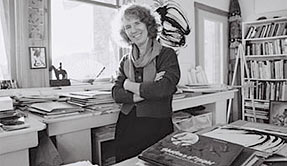 Barbara Bash is a calligrapher, illustrator, author and performance artist. She has written and illustrated many books on natural history for adults and children. She also teaches workshops in illustrated journaling, expressive brush calligraphy, and communication practices.
Barbara Bash is a calligrapher, illustrator, author and performance artist. She has written and illustrated many books on natural history for adults and children. She also teaches workshops in illustrated journaling, expressive brush calligraphy, and communication practices.
Barbara spent her childhood in Barrington, Illinois and studied dance and drawing in college before immersing herself in the study of calligraphy. This art form led her to a successful career as a graphic artist and teacher of book arts, first in the California Bay Area and then at Naropa University in Boulder, Colorado. During these years she collaborated with storytellers, dancers and musicians in performance. She also began to study the natural world through writing and illustrating books for children. The research for her books has taken her all over the world and opened her to the practice of illustrated journal keeping. True Nature was her first published journal. She now lives and works in the Hudson Valley of New York where she creates her books and does expressive calligraphic performance art.
Her workshops have been presented in Buddhist centers and corporate settings, as well as prisons and mental health facilities, creating a space for everyone to make their mark in the world.

